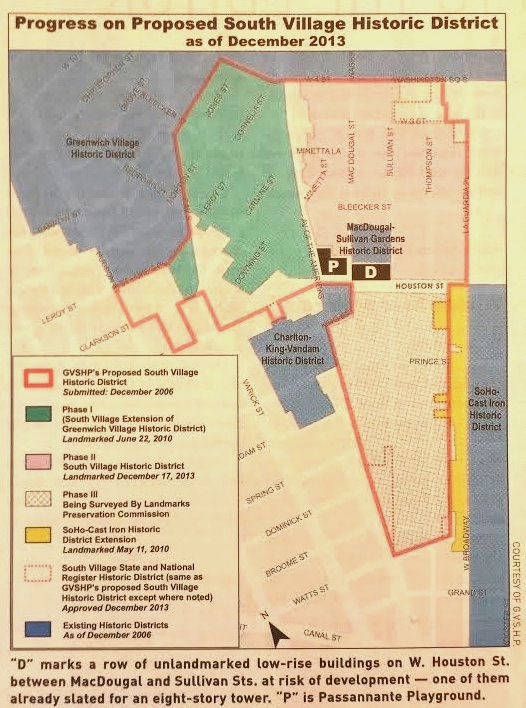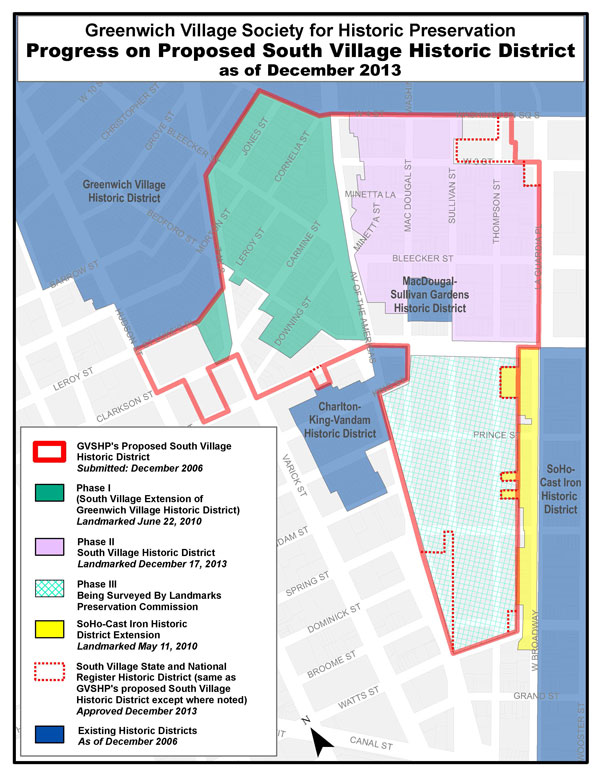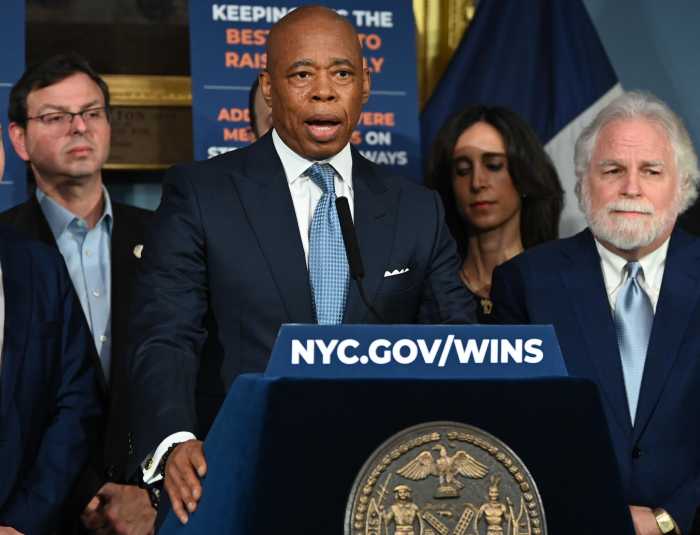BY ANDREW BERMAN | Word that an eight-story building is planned for 134 W. Houston St., next to the MacDougal Sullivan Gardens, has refocused attention on the unfinished fight to preserve the historic South Village, and to protect it from overdevelopment.
We’ve made incredible progress since the Greenwich Village Society for Historic Preservation first started pushing the city to preserve this area 10 years ago: Two historic districts containing nearly 500 buildings on more than two dozen blocks have been designated, protecting a huge slice of our neighborhood’s history and preventing high-rise development by New York University and others.
But these recent plans highlight the fact that a large chunk of this historic neighborhood has still not been landmarked, including the entire section south of Houston St., and that much of this area has zoning that would allow new developments as tall as 250 feet, or even greater.
In 2006, G.V.S.H.P. submitted a formal proposal to the city to landmark the entire South Village. Earlier this year we also proposed a “contextual rezoning” of the neighborhood, which would impose height limits for new development where none currently exist. The city designated the first phase of our proposed landmark district in 2010, covering much of the area between Sixth Ave. and Seventh Ave. South, and Houston and W. Fourth Sts. The city designated the second phase in late 2013, covering much of the area between Sixth Ave. and LaGuardia Place, Houston St. and Washington Square.
But a couple of key sites were excluded, including the row of 1840s houses on the north side of Houston St. between MacDougal and Sullivan Sts., where the new eight-story development is planned. And under the prior administration, the city’s Landmarks Preservation Commission refused to consider the remaining section of G.V.S.H.P.’s proposed South Village Historic District, a triangular swath covering about 200 buildings on 11 blocks stretching from Houston St. south to Watts St., from Sixth Ave. to the east side of Thompson St.
So we’ve been pushing the new administration — which has been quite willing to reconsider policies and decisions of the prior administration — to move ahead with landmarking the remainder of the South Village. But the administration’s position on this, as well as on our rezoning proposal for the area, still remains to be seen.
I met recently with the new chairperson of the Landmarks Preservation Commission, Meenakshi Srinivasan, and raised with her the incredible importance of landmarking the remainder of the South Village. The proposed eight-story building adjacent to MacDougal Sullivan Gardens — a landmarked, historic complex of 22 three-and-a-half-story 1840s houses with shared communal backyards — is unfortunately only the tip of the iceberg in terms of threats the South Village faces.
In 2012, 186 Spring St., an 1824 rowhouse that was determined eligible for the National Register of Historic Places for the vital role it played in the L.G.B.T. (Lesbian, Gay, Bisexual and Transgender) civil rights movement, was demolished after the city refused to save it, in spite of pleas from G.V.S.H.P., elected officials across the city and a bevy of L.G.B.T. groups.
In 2013, 54 MacDougal St., an 1820 rowhouse with historical connections to Alexander Hamilton and Aaron Burr, as well as prominent early New York families the Ludlows and Weeks, was allowed to be demolished by the city over similar strenuous objections. Both sites remain nothing more than holes in the ground.

What could be built on these and other South Village sites is perhaps more disturbing. For the most part, the South Village has zoning that encourages tall towers surrounded by open space. On smaller sites, typically no more than an eight-story building can be built. But on a large enough site, new construction in the South Village could easily reach 250 to 300 feet in height.
That is why we fought so hard to get N.Y.U. Law School’s Vanderbilt Hall included in the South Village Historic District designated in 2013. Covering an entire city block on Washington Square South, without landmark protections, the low-rise, brick and stone law school could have easily been demolished and replaced with a 300-foot-tall dorm. Given N.Y.U.’s unceasing penchant for expansion, this no doubt would have eventually happened. Fortunately, due to our success in getting the building included in the new landmark district, such a development should now no longer be possible.
But there are other sites in the South Village where an assemblage of this size is possible, and a development of this scale not only feasible, but in many ways, encouraged under the existing zoning.
That’s why we must get the city to agree to landmark protections for the remaining sections of the South Village, or a contextual rezoning — or both, as G.V.S.H.P. has proposed.
There’s too much at stake. The South Village is truly one of New York and the nation’s treasures — a neighborhood of incredibly rich history reflecting the immigrant experience of the late 19th and early 20th centuries, and revolutions in music, the arts, literature, society and culture.
That’s why in 2012, G.V.S.H.P. successfully nominated the South Village as one of the seven most important, endangered historic sites in New York State, as chosen by the Preservation League of New York State. And that’s also why G.V.S.H.P. nominated the entire South Village for listing on the State and National Registers of Historic Places — a designation approved earlier this year.
The remaining roughly one-third of the South Village still lacking landmark protections includes some of the most vital historic sites the neighborhood — from the 1886 St. Anthony of Padua Church, at 155 Sullivan Street, the country’s oldest extant Italian-American church, to countless early 19th-century houses, colorful and varied late 19th-century tenements, and innovative 20th-century housing developments and institutions.
Not only could these buildings be lost at any time, but without appropriate landmark and zoning protections for the whole area, even the landmarked portions of the South Village are not entirely safe. The planned eight-story development at 134 W. Houston St. will, for instance, loom over the neighboring landmarked three-and-a-half-story houses of MacDougal Sullivan Gardens. If a developer (or N.Y.U.) were to assemble that entire row of houses, that development could grow to a 250-foot-tall tower!
Support for extending landmark and zoning protections to the remainder of the South Village enjoys virtually unanimous support from local elected officials, civic groups and Community Board 2. Now it’s time for the city to get onboard, and move ahead with this much-needed and long-overdue proposal.
If you want to help, you can send a letter to the mayor and Landmarks Preservation Commission chairperson by going to gvshp.org/svlet.
Berman is executive director, Greenwich Village Society for Historic Preservation





































